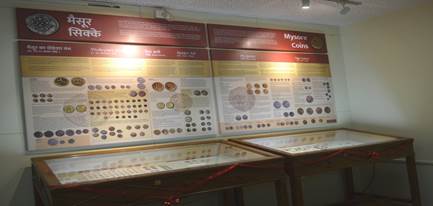The Reserve Bank of India’s Monetary Museum unveiled a special display on Mysore Coins on August 20, 2015. Dr. Deepali Pant Joshi, Executive Director inaugurated the special display. A 20-page information brochure on Mysore Coins displays was also released on the occasion. Shri U. S. Paliwal, Executive Director, Prof. Damodar Acharya, Director on the Reserve Bank’s Central Board of Directors and Shri S Ramaswamy, Regional Director, Mumbai Office were present.

Special Display of Mysore Coins at RBI’s Monetary Museum The display comprises 112 Mysore coins (13 coins in gold, 6 in silver and 93 in copper), covers the monetary history of Mysore for a period of four centuries starting from AD 1565 after the battle of Talikota. The display emphasises the coins issued under the Mysore Wodeyars, Haider Ali and Tipu Sultan. Gold coins were found in large number under Mysore rulers. Kanthirava Narasaraya was the first ruler to issue gold coins, known as Kanthirava varaha and half varaha which weighed 3.5 gms and 1.7 gms, respectively, with Lakshmi Narasimha on one side and three line Nagari legend mentioning his name on the other. He also issued gold panam weighing 0.35 gms with Narasimha on one side and his name on the other. Diwan Purnaiya later reintroduced Gidda Kanthirava panam (gidda literally meaning 'thick') under Krishnaraja III (AD 1799 - 1832). The tradition continued during the time of Haider Ali and Tipu Sultan.
To see all these and more, please visit the RBI Monetary Museum, Amar Building (Ground Floor), Sir P M Road, fort, Mumbai 400 001. Timing: 10.45 to 17.15 Tuesday to Sunday; Closed on Monday and Bank Holidays.
Alpana Killawala
Principal Chief General Manager
Press Release : 2015-2016/519 |